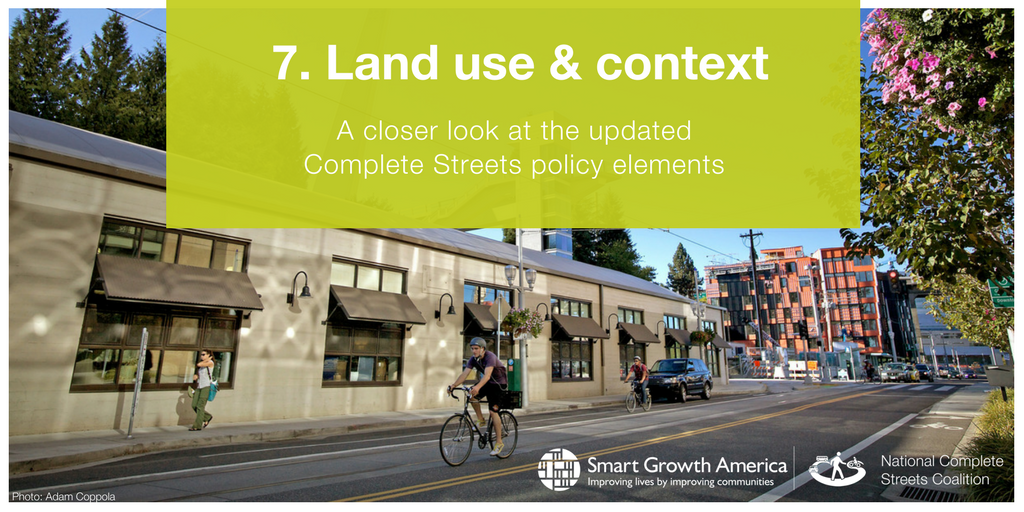
News
By Nimotalai Azeez, November 21, 2017

We’ve raised the bar for this element of our Complete Streets policy framework to better account for land use and context. In our previous framework, we gave points to policies that simply mention community context in decision making. Now, the updated framework requires Complete Streets policies to integrate land use policies, plans, zoning ordinances, or equivalent documents from jurisdictions at all levels of government.
This post is part of Complete Streets month at Smart Growth America; we will be sharing a series of blog posts that cover and explain each of the 10 revised policy elements in some detail.
An effective Complete Streets policy must be sensitive to the surrounding community, including its current and planned buildings, parks, and trails, as well as its current and expected transportation needs. It is critical to recognize the connection between land use and transportation. Complete Streets must be designed to serve the current and future land use, while land use policies and zoning ordinances must support Complete Streets such as by promoting dense, mixed-use, transit-oriented development with homes, jobs, schools, transit, and recreation in close proximity depending on the context.
“People don’t care what the underlying transportation function of a street is. What we care about is whether we can safely and reliably use our streets to access the places we want to go, on foot, by bike or transit, or by car. The Land Use and Context Sensitivity element supports integrative decision-making by matching street designs with the planned land use context and adopting a diverse mix of land uses that encourage shorter trips. This makes the places we want to go safer and easier to get to.”
– Drusilla van Hengel – Principal, NelsonNygaard
The best Complete Streets policies will meaningfully engage with land use by integrating transportation and land use in plans, policies, and practices. We also encourage a more detailed discussion of adapting roads to fit the character of the surrounding neighborhood and development, as well as the consideration of unintended consequences such as displacement of residents due to rising costs of living. Below is a brief explanation of what should be included in this policy element, depending on the type of policy.
- For municipality/county policies – Policy requires new or revised land use policies, plans, zoning ordinances, or equivalent documents to specify how they will support and be supported by the community’s Complete Streets vision
- For state/Metropolitan planning organization policies – Policy requires new or revised long-range transportation plans and/or design guidance to specify how transportation projects will serve current and future land use such as by directing the adoption of place-based street typologies
- For all policies – Policy requires the consideration of the community context as a factor in decision-making. Policy specifies the need to mitigate unintended consequences such as involuntary displacement.
“Land use & context sensitivity” is just one of 10 policy elements that will be featured this month. We’ve officially revised our policy grading rubric, known as the 10 Elements of a Complete Streets Policy. The Complete Streets movement has evolved since it began in 2004 to focus far more on implementation and equity, but the framework for grading the quality of policies hasn’t kept pace. For months, a group of national stakeholders, consisting of engineers, planners, researchers, and advocates, worked to revise the policy elements and truly raise the bar for what Complete Streets look like in practice. The entire revised framework will be available on our website on November 30, 2017.
Stay tuned for more Complete Streets updates during the month of November
- Have questions about the changes? Join us as we discuss how the new grading rubric will affect future policies during our webinar on December 1, 2017 at 1:00pm ET. The entire new grading rubric resource will be released on our website shortly before the webinar. Register for the webinar today >>
- We are now accepting nominations for the Best Complete Streets initiatives. Do you know of a project, initiative, event, person, task force, etc. that exemplifies Complete Streets? Fill out this brief nomination form >>
If you have any questions about the changes to the Complete Streets policy framework, please contact us! We’re happy to discuss further.
Special thanks to our featured Steering Committee members:

NelsonNygaard is an industry leader in holistic planning for all modes of transportation. We rely on our national and international experience to develop solutions for everyone in the context of a community’s needs and goals.
Related News

© 2025 Smart Growth America. All rights reserved
Site By3Lane Marketing
















